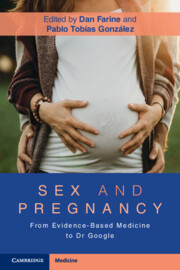Book contents
- Sex and Pregnancy
- Sex and Pregnancy
- Copyright page
- Dedication
- Contents
- Contributors
- Preface
- Section 1 General Issues
- Chapter 1 From Sex for Reproduction to Reproduction without Sex
- Chapter 2 Sex in Pregnancy
- Chapter 3 Physiology of Pregnancy As Related to Sex
- Chapter 4 Does Orgasm Affect Fetal Well-Being?
- Chapter 5 Demographics of Sexual Behavior in Pregnancy
- Chapter 6 Sexual Practices during Pregnancy in Different Cultures
- Chapter 7 What Do Obstetric Guidelines Say?
- Chapter 8 Using the Internet to Educate on Sex and Pregnancy
- Section 2 Specific Issues
- Index
- References
Chapter 8 - Using the Internet to Educate on Sex and Pregnancy
Grading Internet Information
from Section 1 - General Issues
Published online by Cambridge University Press: 09 November 2022
- Sex and Pregnancy
- Sex and Pregnancy
- Copyright page
- Dedication
- Contents
- Contributors
- Preface
- Section 1 General Issues
- Chapter 1 From Sex for Reproduction to Reproduction without Sex
- Chapter 2 Sex in Pregnancy
- Chapter 3 Physiology of Pregnancy As Related to Sex
- Chapter 4 Does Orgasm Affect Fetal Well-Being?
- Chapter 5 Demographics of Sexual Behavior in Pregnancy
- Chapter 6 Sexual Practices during Pregnancy in Different Cultures
- Chapter 7 What Do Obstetric Guidelines Say?
- Chapter 8 Using the Internet to Educate on Sex and Pregnancy
- Section 2 Specific Issues
- Index
- References
Summary
The vast expansion of data via the Internet did not overlook health and healthcare information. However, lack of supervision, the amount of data, and misleading information online has a profound impact on the health of patients themselves and on the quality and efficiency of healthcare. Many pregnant women utilize the Internet as a major source of information and use the unsupervised information to navigate pregnancy and fertility-related decisions due to its accessibility. The Internet has become a major information tool for obstetricians and gynecologists as well, with over 90% of physicians using it on a daily basis. In addition, any physician needs to know what are the trends in the media and to address them accordingly when confronted by a patient. We describe the essential steps when searching online in order to find the most reliable information: (1) consider the source, by verifying the credentials of and information about the authors; (2) focus on quality, by using only peer-reviewed published data; (3) consider website funding, by distinguishing advertisements from health information; (4) protect your privacy and personal information; and (5) there are no magical solutions, so suspect websites or companies that claim dramatic results and which seem too good to be true.
- Type
- Chapter
- Information
- Sex and PregnancyFrom Evidence-Based Medicine to Dr Google, pp. 49 - 54Publisher: Cambridge University PressPrint publication year: 2022

